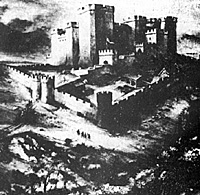 MILITARY ARCHITECTURE by Quentin Hughes. 256 pages; more than 300 photographs, plans and drawings - Hugh Evelyn - £ 6.50p).
MILITARY ARCHITECTURE by Quentin Hughes. 256 pages; more than 300 photographs, plans and drawings - Hugh Evelyn - £ 6.50p).
At a recent meeting of the Wessex Military Diner's Club, a Member proudly displayed a copy of this book which immediately aroused the greatest interest through the sumptuous manner in which it portrayed and described military buildings through the ages. Being one who has an addiction to good books, I immediately set about obtaining a copy and I have no hesitation whatsoever in stating that this is a volume that will rank high in my library and one which I am proud to display to my friends. It is a really gorgeous production and the author is to be congratulated on the immense labour that has gone into his researches, coupled with the simply first- class photographs and drawings whilst the publisher has certainly done him proud - and I speak as an author who has not always been entirely satisfied with the manner of presentation of my own books!
Armed with this volume, no wargamer has any excuse for inaccuracy in reproducing fortifications; indeed, the comparative neglect of siege warfare as a table-top reconstruction might well receive a much needed stimulus by the publication of this book. For example, if you are an Ancients fan, then have a look at the drawing of the fortified walls of Tiryns on page 10 and then think about garrisoning such a place with your Ancient Greeks! The book begins with the Ancient world, discusses fortifications and attacks upon them including details of siege engines and their operation; Castles of the Middle Ages are well covered and include many familiar to us in this country, including those built by Edward I in Wales. I was interested and somewhat ashamed to note the photographs of some wonderful castles in Italy at places which I remember visiting during my three years in that country in World War II -- I must have been a blind and uncomprehending soldier because I cannot recall seeing any of them. Probably I was more interested in looking for bars, eggs and chips and Italian girls!
The fortifications of the Renaissance have a sort of a "toy land" appearance as many of them look like the fairy tale castles depicted in children's books. The Baroque period explains the defence-in-depth method as typified in this country by Deal Castle and we begin to see the more familiar appearance of the fortifications of Vauban', the daddy of them all. Having clambered around numerous fortifications such as Almeida, Ciudad Rodrigo, Burgos and Badajoz while being ably instructed by that expert David Chandler, I have a great feeling for these 17th and 18th century defence works and great justice is done to them in these pages. This particularly applies to Fort George at Inverness where I recall spending a fascinating if chilly afternoon with Members of the Wessex Military Society. The fortifications of the 19th century, leading up to those refurbished fortresses of World War I fame, such as Liege and those at Verdun, are also of the greatest interest to me and I have many interesting hours clambering round gun emplacements in the Forts on Portsdown Hills overlooking Portsmouth and Hurst Castle at the mouth of the Solent. Perhaps it is because I have an imagination and I am deeply interested in things military so that, once in these ancient buildings, I can become almost mystically attuned and rarely fail to sense the underlying atmosphere of the place. When I say that I obtained traces of that same feeling when looking at the photographs and rifling through the pages of this book, I am indeed praising its compelling aspects. I cannot speak too highly of MILITARY ARCHITECTURE.
Book Review
- Military Architecture
Military Modelling Annual
Journal of the Society for Army Historical Research Vol II 1923
Legacy of Glory
Bill Thurbon on Books
Back to Table of Contents -- Wargamer's Newsletter # 154
To Wargamer's Newsletter List of Issues
To MagWeb Master Magazine List
© Copyright 1975 by Donald Featherstone.
This article appears in MagWeb (Magazine Web) on the Internet World Wide Web.
Other military history articles and gaming articles are available at http://www.magweb.com